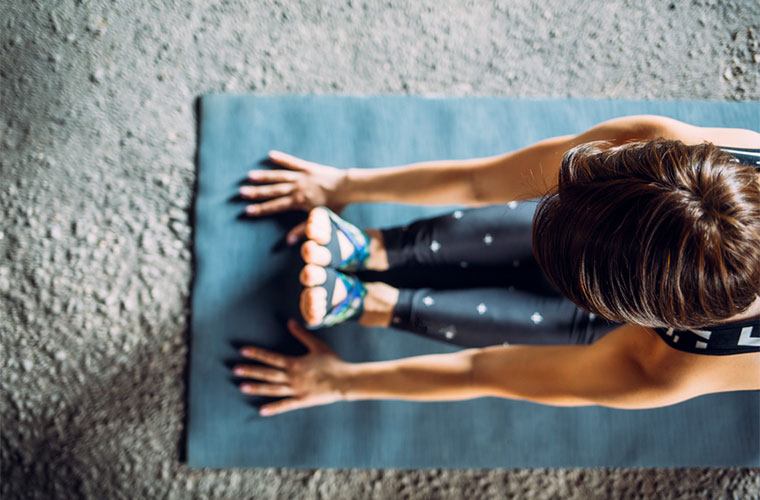I Worked Out Twice a Day Until It Started Messing With My Hormones
I'd do my Olympic weightlifting or a "Workout of the Day" (WOD) in the morning, and then take a 7 p.m. CrossFit class at night. My body was definitely sore, but two-a-days were my time to socialize. After all, who needs coworkers when you've got workout buddies?
All was well until a subtle shift started happening inside my body. I felt off. Even after 8 or 9 hours of sleep, I'd wake up wiped and craving coffee. Workouts that usually left me glowing, instead turned me into a washed-up blob on the floor. I phoned a doctor friend, who suspected that all the high-intensity exercise was messing with my cortisol—you know, that pesky stress hormone—levels. She was right. Here's the low-down on the hormone, how exercise impacts it, and what to do if flare-ups leave you feeling...off.

What exactly is cortisol?
Cortisol is in charge of regulating changes in the body that happen in response to anxiety and tension, and it plays a role in managing our bodies fight-or-flight response. "Cortisol is secreted by the adrenal glands, which are little glands on top of your kidneys that look like hats," says Kecia Gaither, MD, MPH, FACOG. "Your cortisol levels naturally rise and fall throughout the day. For most people, cortisol spikes in the morning when you first wake up, lulls in the afternoon, and may spike again in the late evening." You know that feeling you describe as a "second wind"? That's your cortisol cycle talking.

{{post.sponsorText}}
When your hormonal levels are balanced, you feel calm and collected, alert, and in stasis. "When they're out of balance, you might experience fatigue, insomnia, irregular periods, increased appetite, problems with blood sugar regulation, weight gain, increased inflammation, and decreased libido," says Robin Berzin, MD, founder and CEO of Parsley Health.
"It can also cause a generalized sense of burnout, digestive issues, and migraines," adds behavioral health therapist, Danielle Swimm, MA, LCPC, who says if you feel like any of these symptoms are familiar to you, to consider seeking advice from a healthcare professional.
The relationship between exercise and cortisol
So what in the heck does all of this have to do with fitness? "When you do really high intensity exercise or endurance exercise, your body releases cortisol in response to the stress," she says. In fact, research suggests that moderate to high-intensity exercise may increase cortisol. Generally, that increase is seen as acute—meaning it won’t have long-term effects. "But if you’re doing intense workouts more than once a day and several days a week, your cortisol levels will stay elevated," says Dr. Berzin.
In the short term, Gaither says a tell-tale symptom is slowed recovery between sets and increased resting heart rate. In the long term, however, these consistently elevated cortisol levels can lead to the health woes that you likely work out to avoid: blood pressure, diabetes, weight gain, osteoporosis, and even impaired fertility. "If cortisol levels are chronically high, it can increase hormones like testosterone and subsequently estrogen, while also decreasing hormones like progesterone. Which can cause disruptions in the menstrual cycle and acne," says Dr. Berzin. This leads to what’s referred to as the "female athlete triad"—a combination between irregular or absent periods, low bone mineral density, and not a lick of energy.

High cortisol levels don't have to mean the end of your fitness routine
So let's get right down to it. Does that mean that if you have high cortisol levels you have to stop working out all together? No. "The solution is to adjust your workouts. So instead of doing daily high intensity workouts, incorporate yoga and gentle exercise," says Suzie Welsh RN, an adjunct professor at Villanova University's School of Nursing and founder of BINTO. "Exercise is obviously a very good-for-you thing if done at the right intensity, and the right amount. The goal is find balance in both your workout routine and your cortisol levels."
Once I ID-ed the route of my blah-ness, my cortisol levels didn't automatically return to normal. It took a while. For over a month I committed to healing my body: I went to sleep at 10 each night and let myself sleep until 7 or 8 in the morning. I quit chugging coffee as soon as I woke up (turns out: that can also throw off hormones). I started taking rhodiola which is thought to help the body cope with stress. And most importantly: I incorporated restorative exercise like yoga and RomWOD into my fitness schedule.
I also took a serious look at why I was going to the gym so often. Turns out sometimes it was because I was just bored of working from home, or craving mid-day human interaction. I started scheduling two to three lunch dates a week, and surrounding myself with fellow WFHers in the afternoon, which is the time when I frequently start to feel isolated. I even started making plans to hang with my fit-fam outside of the gym (gasp!). Eventually, everything fell into equilibrium. Once or twice a week, I still work out twice a day, but I workout smarter than ever before. And that's a win in my book.
Prepare yourself before hitting an intense class: Take this test to gauge your fitness level, and master proper form for these four common exercises.
Loading More Posts...